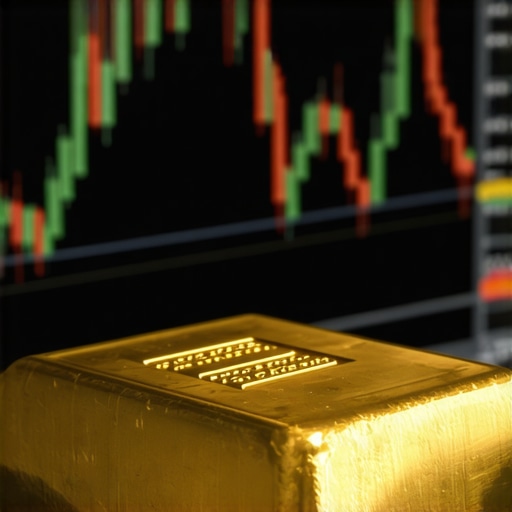Analyzing Gold’s Strategic Role Amid 2025’s Economic Landscape
The year 2025 presents a highly complex environment for gold investors, shaped by multifaceted geopolitical tensions, fluctuating inflation rates, and evolving central bank policies. Understanding these dynamics is essential for anticipating gold price trajectories and optimizing portfolio allocation. Gold remains a cornerstone asset in risk management strategies, particularly as global markets confront uncertainty and potential volatility.
Key Drivers Shaping Gold Price Forecasts in 2025
Monetary Policy Tightening and Its Counterintuitive Impact on Gold
Despite expectations that rising interest rates typically dampen gold’s appeal due to increased opportunity costs, 2025 may reveal a nuanced relationship. Persistent inflation pressures alongside aggressive Federal Reserve tightening could paradoxically bolster gold’s safe-haven demand, as real yields remain subdued or negative. Investors should monitor yield curve dynamics and inflation expectations closely to anticipate gold price inflection points.
Supply Constraints and Central Bank Demand: A Delicate Balance
Global gold supply continues to face challenges including labor disruptions in mining regions and regulatory hurdles. Concurrently, central banks, particularly in emerging markets, are accelerating gold reserve accumulation as a geopolitical hedge. This dual pressure—restricted supply juxtaposed with heightened institutional demand—creates a bullish underpinning for gold prices in 2025. For a comprehensive exploration of central bank influences on gold demand, see our detailed analysis here.
Advanced Investment Perspectives: Diversification and Hedging Strategies
How Can Investors Leverage Gold ETFs and Physical Gold to Optimize Portfolio Stability?
Integrating both gold ETFs and tangible bullion presents sophisticated hedging advantages. ETFs provide liquidity and ease of access, while physical gold, including bars and coins, offers protection against counterparty risk and systemic shocks. Balancing these holdings can mitigate volatility and enhance portfolio resilience amidst uncertain market cycles. For detailed guidance on selecting gold investment vehicles, visit our expert resource.
Emerging Trends in Gold Futures and Mining Stocks
Advanced investors are increasingly exploring gold futures trading to capitalize on short-term price movements, while mining stocks offer leveraged exposure to gold price appreciation. However, these instruments demand rigorous market analysis and risk management techniques. Mastery of gold trading strategies and understanding of mining sector fundamentals will be critical for 2025 success, as outlined in our comprehensive guides on gold futures and mining stocks.
Contextual CTA
For investors seeking to deepen their expertise and refine their 2025 gold investment strategies, explore our advanced insights on gold price forecasts and contribute your perspectives in our expert community forums.
Authoritative External Citation
According to the World Gold Council’s 2024 report, central bank purchasing and supply-demand imbalances remain pivotal factors influencing gold’s medium-term price outlook (World Gold Council, 2024).
Technological Innovations Impacting Gold Market Transparency and Trading
Technological advancements are reshaping the gold investment landscape by enhancing transparency, liquidity, and execution speed. Blockchain-based platforms for gold trading have emerged, providing immutable records of provenance and ownership, which reduce counterparty risk and fraud. Additionally, algorithmic trading tools enable investors to react to market signals and price volatility with precision, optimizing entry and exit points. These innovations are particularly crucial in 2025 as market complexity demands sophisticated analytical capabilities.
What Role Will Artificial Intelligence Play in Forecasting Gold Price Movements?
Artificial intelligence (AI) and machine learning models are increasingly utilized to decode complex variables influencing gold prices, such as macroeconomic indicators, geopolitical risks, and sentiment analysis from news and social media. By processing vast datasets, AI can identify subtle patterns and correlations that traditional analysis might miss. This capability could offer investors predictive advantages in timing gold purchases or sales, effectively managing risk and capitalizing on market shifts. However, reliance on AI models requires careful validation and understanding of their limitations.
For investors interested in detailed methodologies and applications of AI in commodity markets, the World Gold Council’s research on innovation in gold markets provides an authoritative resource.
Integrating Gold into Multi-Asset Portfolios: Beyond Traditional Approaches
Modern portfolio theory advocates diversification, but 2025 calls for a nuanced approach that incorporates dynamic allocation and scenario-based stress testing. Gold’s low correlation with equities and bonds is well documented, but its behavior during hyperinflationary or stagflationary environments amplifies its strategic value. Investors should consider tactical shifts between physical gold, ETFs, futures, and mining equities to optimize risk-adjusted returns.
Moreover, understanding tax implications and liquidity constraints across these instruments is essential to crafting effective strategies. Our comprehensive guide on balancing gold and stocks explores these considerations in depth.
Contextual CTA
Engage with our expert community by sharing your insights or questions about leveraging AI tools for gold investment and balancing diversified portfolios in 2025. Your participation enriches the collective knowledge and sharpens investment strategies.
Blockchain’s Disruptive Potential: Elevating Gold Market Integrity and Investor Confidence
In 2025, blockchain technology is not just a buzzword but a transformative force in gold trading ecosystems. By establishing decentralized ledgers, blockchain ensures transparent and tamper-proof tracking of gold provenance, ownership transfers, and transactional history. This innovation mitigates traditional concerns over counterfeit gold and opaque supply chains, fostering heightened trust among institutional and retail investors alike.
Moreover, smart contracts on blockchain platforms automate settlement processes and enforce compliance requirements, significantly reducing counterparty risk and operational inefficiencies. This technological leap facilitates fractional ownership models, democratizing access to gold investments beyond conventional barriers. Investors should consider integrating blockchain-verified gold assets into their portfolios to capitalize on increased liquidity and security benefits.
How Does Blockchain Implementation Affect Regulatory Compliance and Market Liquidity in Gold Trading?
Blockchain’s immutable record-keeping simplifies regulatory audits by providing real-time transparency into gold transactions, enabling faster compliance verification with anti-money laundering (AML) and know-your-customer (KYC) mandates. Enhanced traceability curtails illicit activities and strengthens market integrity, which can attract greater institutional participation and improve overall liquidity.
However, regulatory frameworks are evolving to address jurisdictional nuances around decentralized platforms, requiring investors and intermediaries to stay abreast of compliance developments to avoid legal pitfalls. Collaborative initiatives between regulators and blockchain consortia are underway to harmonize standards and foster responsible innovation.
Advanced AI-Driven Sentiment Analysis: Unlocking Hidden Market Signals for Gold Traders
The integration of natural language processing (NLP) and sentiment analysis into gold market analytics provides an unprecedented edge. By mining vast datasets comprising geopolitical news, central bank communications, and social media chatter, AI models discern subtle shifts in investor sentiment that precede price movements.
For example, nuanced changes in tone within Federal Reserve statements or emerging geopolitical flashpoints can be quantified and incorporated into algorithmic trading strategies. This dynamic approach allows traders to adjust exposure proactively rather than reactively, potentially enhancing alpha generation while managing downside risks.
Notably, AI’s capacity to synthesize multi-dimensional data outperforms traditional univariate models, offering a more holistic and adaptive framework for gold price forecasting. Investors keen on adopting these cutting-edge tools should evaluate vendor credibility and model transparency to ensure robustness.
Authoritative insights into these methodologies are detailed in the World Gold Council’s 2024 research, which underscores AI’s growing role in commodity markets.
Harmonizing Traditional and Digital Modalities: Crafting a Hybrid Gold Investment Portfolio
The convergence of conventional gold investment vehicles with digital innovations invites sophisticated portfolio construction strategies. Allocating assets across physical bullion, ETFs, blockchain-verified tokens, and algorithmically managed futures can optimize diversification and risk-adjusted returns.
Such hybrid portfolios benefit from the stability and tangibility of physical gold, the liquidity and cost efficiency of ETFs, and the transparency and automation enabled by blockchain and AI. Yet, this complexity necessitates rigorous due diligence, including assessment of counterparty risk, technological vulnerabilities, and regulatory exposure.
Investors should engage with financial advisors versed in both traditional and emerging gold markets, leveraging scenario-based stress tests and advanced analytics to tailor allocations that align with their risk tolerance and investment horizon.
Contextual CTA
To deepen your mastery of integrating blockchain and AI advancements into gold investment strategies, explore our expert webinars and join discussions in our dedicated forums. Embrace innovation to navigate 2025’s gold market complexities with confidence.
Leveraging Cutting-Edge Analytics for Gold Market Precision
As the gold market evolves, the fusion of artificial intelligence (AI) and blockchain technologies offers unprecedented avenues for sophisticated investors to refine decision-making processes. AI-driven predictive analytics, when combined with blockchain’s transparency, enable granular tracking of market sentiment, supply chain integrity, and transactional security, facilitating a holistic view of factors influencing gold pricing dynamics.
Can Combining Blockchain and AI Technologies Revolutionize Gold Price Forecasting and Risk Management?
Indeed, integrating blockchain’s immutable data records with AI’s pattern recognition capabilities creates a synergy that enhances forecasting accuracy and risk mitigation. Blockchain ensures verifiable provenance and real-time transaction data, which feed into AI algorithms to detect anomalies, market manipulations, or emerging trends. This multidisciplinary approach transcends traditional models by incorporating decentralized trust and advanced computation, empowering investors to anticipate volatility and optimize entry points with greater confidence.
For an authoritative perspective on these innovations, the World Gold Council’s 2024 Innovation Report provides comprehensive insights into how these technologies reshape commodity market structures.
Quantitative Strategies: Algorithmic Trading Meets Gold’s Intrinsic Value
Advanced portfolio managers increasingly employ quantitative models that integrate macroeconomic indicators, sentiment analysis, and blockchain-verified supply data to construct algorithmic trading strategies tailored for gold markets. These strategies exploit short-term inefficiencies while anchoring decisions to gold’s fundamental value, balancing speculative agility with intrinsic asset security.
Regulatory Evolution and Compliance in a Digitally Enhanced Gold Ecosystem
Emerging regulatory frameworks aim to reconcile innovation with investor protection. Blockchain’s transparency simplifies compliance with AML and KYC mandates, yet evolving jurisdictional requirements necessitate continuous vigilance. Sophisticated investors must navigate these regulatory landscapes by collaborating with compliant platforms and leveraging legal expertise to ensure unimpeded market access.
Strategic Asset Allocation: Integrating Digital Gold Tokens into Diversified Portfolios
Digital gold tokens, underpinned by blockchain, are gaining traction as liquid, fractional ownership instruments complementing physical gold and ETFs. Their programmable nature allows for dynamic rebalancing and automated portfolio optimization, aligning with modern investment mandates emphasizing flexibility and scalability.
However, investors must meticulously assess technological risks, counterparty reliability, and underlying asset custody mechanisms to harness benefits fully.
Contextual CTA
Elevate your gold investment acumen by exploring our advanced resources on AI and blockchain integration. Join our expert-led webinars and active forums to exchange insights and stay ahead in the rapidly transforming gold market landscape for 2025.
Expert Insights & Advanced Considerations
Monetary Policy Complexity and Gold’s Safe-Haven Dynamics
In 2025, the interplay between aggressive central bank rate hikes and persistent inflation creates a rare environment where gold’s traditional inverse relationship with interest rates may not hold. Investors should focus on real yields and inflation-adjusted returns, as gold’s safe-haven appeal strengthens when real yields remain negative despite nominal rate increases. This nuanced dynamic demands a sophisticated understanding of macroeconomic data and monetary policy signals.
Blockchain as a Catalyst for Market Integrity and Fractional Ownership
Blockchain integration is revolutionizing gold investment by enabling transparent provenance tracking and facilitating fractional ownership through tokenization. This technology reduces counterparty risk and operational inefficiencies, making gold more accessible to a wider investor base while increasing market liquidity. However, careful evaluation of platform credibility and regulatory compliance remains paramount for institutional and retail participants.
AI-Driven Sentiment Analysis Enhances Predictive Accuracy
Advanced AI models employing natural language processing to analyze geopolitical developments, central bank communications, and social media sentiment are transforming gold price forecasting. These tools detect subtle market signals and emerging risks ahead of traditional indicators, providing traders and portfolio managers with a predictive edge. Nonetheless, reliance on AI outputs requires critical appraisal to avoid overfitting and model limitations.
Hybrid Portfolio Construction: Integrating Physical, Digital, and Derivative Gold Assets
Combining physical bullion, ETFs, blockchain-verified tokens, futures, and mining stocks offers a multifaceted approach to diversification and risk management. This hybrid strategy captures gold’s intrinsic value and leverages technological innovations to optimize liquidity and returns. Investors should apply scenario-based stress testing and engage with advisors experienced in both traditional and digital assets to tailor robust allocations.
Regulatory Evolution Necessitates Vigilant Compliance Strategies
The evolving legal landscape around blockchain and AI applications in gold markets requires proactive compliance management. Investors and platforms must adapt to jurisdiction-specific AML, KYC, and securities regulations while advocating for harmonized standards. Staying informed about regulatory developments ensures uninterrupted market participation and mitigates legal risks.
Curated Expert Resources
- World Gold Council Research Hub: An authoritative source for in-depth reports on gold market innovation, central bank trends, and technological impacts in 2025 (Innovation in Gold Markets).
- BuyingGoldNow: Gold Price Forecast 2025: Comprehensive analysis of key drivers influencing gold prices, including monetary policy and supply-demand factors (Gold Price Forecast 2025).
- BuyingGoldNow: Understanding Types of Gold Investments: Detailed guide on physical gold, ETFs, futures, and mining stocks to inform diversified portfolio construction (Types of Gold Investments).
- BuyingGoldNow: Mastering Gold Trading Techniques: Practical strategies for navigating gold market volatility and leveraging algorithmic trading (Gold Trading Techniques).
- BuyingGoldNow: Physical Gold Storage Solutions: Essential advice on secure storage methods to protect tangible gold assets (Physical Gold Storage Solutions).
Final Expert Perspective
The 2025 gold investment landscape is defined by an intricate convergence of monetary policy complexities, technological innovation, and evolving regulatory frameworks. Gold’s role as a strategic asset is being reshaped through blockchain-enabled transparency, AI-powered predictive analytics, and hybrid portfolio approaches that fuse physical and digital exposures. Mastery of these multifaceted dimensions is essential for discerning investors aiming to optimize risk-adjusted returns and safeguard wealth amid uncertainty. We invite experienced investors and industry professionals to deepen their engagement with these advanced strategies by exploring our curated resources, participating in expert forums, and continuously refining their approach to the dynamic gold market of 2025.










